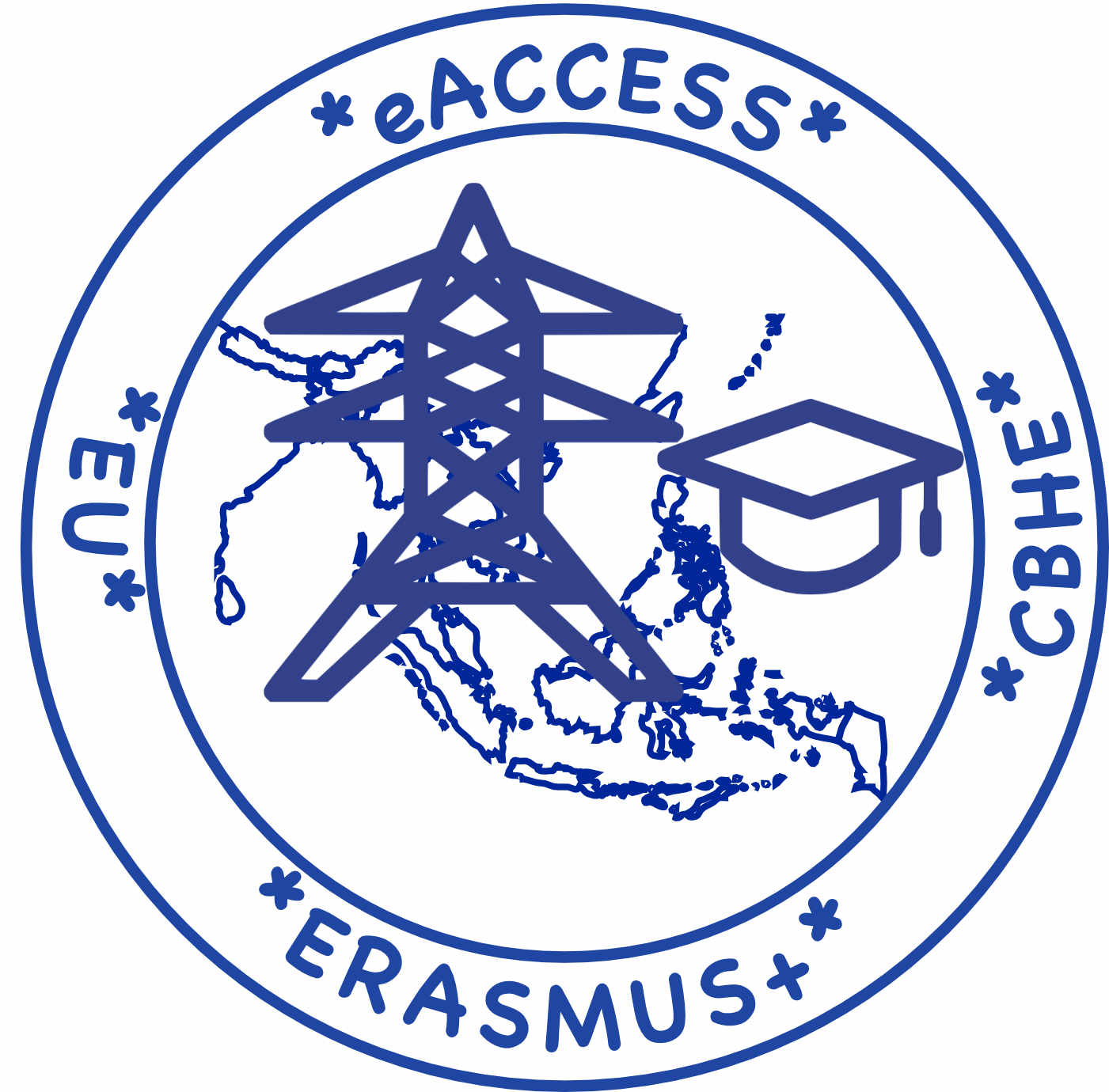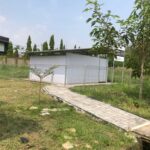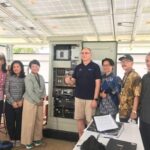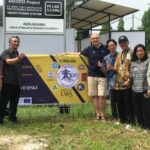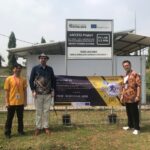Photovoltage Laboratory (eACCESS-PVL)
Supported by the Erasmus+ Programmed of the European Union: Capacity Building within the Field of Higher Education eACCESS Project number: 610041-EPP-1-2019-1-PL-EPPKA2-CBHE-JP
(EU-Asia Collaboration for accessible Education in Smart Power Systems)
Purpose
Currently, almost the whole world is planning to use electrical energy from renewable energy sources. In its development, the use of solar cell power is growing rapidly. Indonesia as a country with the location on the equator, has a great opportunity to develop the use of renewable energy, especially PV. For this chance, with the fund from Erasmus, Atma Jaya Catholic University of Indonesia (ATM) offers a laboratory dedicated to photovoltaic technology, complete with software for the computation of short circuits and coordination of protective systems for the PV power system. This PV laboratory is proposed in order to act in accordance with the current technological advancements, particularly in the field of Renewable Energy (RE). In addition to that, the Indonesian government is currently pushing the usage of RE due to the depletion of fossil fuels. The Indonesian government promotes the use of renewable energy which is considered green energy with sources such as photovoltaic, wind, and bioenergy. The PV Lab installed in this eACCESS Project is a PV Lab that combines several solar modules into one array which can be regulated by the solar controller/solar inverter. The development of the PV lab will give more chances to deepen knowledge and experience of Renewable Energy related issues. The system can be utilized as an off-grid system, using the battery as energy storage, or as an on-the-grid system, by incorporating it with the grid, or a hybrid system.
Under Pillar III in Erasmus+ Capacity Building for Higher Education, eACCESS project, Atma Jaya Catholic University of Indonesia (ATM) has developed and installed the Photovoltage Laboratory. This PV laboratory will help to enrich the knowledge and understanding of undergraduates, technicians, and industrial power system professionals in the field of design, operation, and installation of PV power systems.
Equipment and description
PV MODULES
PV modules, or Photovoltaic modules, are the main components in a Solar Photovoltaic System (SPV). PV modules are solar panels that convert solar energy into electrical energy. Photovoltaic modules consist of photovoltaic cells that generate electric current when exposed to sunlight. PV Lab Atma Jaya Catholic University of Indonesia (ATM) implements 15 x 350 Wp Photovoltaic Module (Monocrystalline type)
BATTERY BANK
These components are used to store excess electrical energy generated by the PV system. The stored energy reserve can be used during periods of low sunlight or when the electricity demand exceeds the direct output from the solar panels. battery bank Pada PV Lab Atma Jaya Catholic University of Indonesia (ATM) terdiri dari 2 baterai. The Battery Bank, equipped with advanced Lithium Ferro Phosphate (LiFePO4) battery technology, serves a multifaceted purpose in enhancing energy management. With an output voltage of 51.2 VDC and a substantial capacity of 10,000 Wh, it ensures a robust energy reservoir.
SOLAR INVERTER
A solar inverter, or photovoltaic inverter, converts solar panel-generated direct current (DC) into alternating current (AC) for household use or grid connection. It has an output power of 2.5 kW and produces 230 V single-phase pure sinewave AC. It features a communication interface for remote monitoring. This device is essential for making solar-generated electricity compatible with standard power needs.
BIDIRECTIONAL INVERTER
A bidirectional inverter, often referred to as a two-way inverter, possesses the remarkable ability to transform electrical currents in two distinct directions. This signifies its capacity to convert solar-generated electricity into a format suitable for household consumption, while simultaneously being capable of converting alternating current (AC) from the grid into direct current (DC), catering to applications such as battery charging or systems reliant on DC power. This Bidirectional Inverter model has a total output power of 3500 VA, producing a pure sine wave output of 220 V AC at 50 Hz within a single-phase configuration. It boasts features like LED/LCD display, battery management system, and power control.
SOLAR CHARGER REGULATOR
A solar charger regulator, also known as a solar charge controller, is crucial for managing battery charging from solar panels. It prevents battery damage from overcharging or over-discharging. With a 4 kWp capacity, it optimizes power transfer using MPPT algorithm. Operating at 48 VDC, it guards against overload, reverse polarity, and battery voltage issues, ensuring efficient and safe battery charging in solar systems.
MONITORING SYSTEM
In the PV system, two components are accessible for monitoring: the battery charger and AC inverter. These devices can engage in external communication using the Serial CAN Protocol. To enable the PV system for Modbus protocol connectivity, the CAN protocol is transformed into Modbus Serial/RTU using a CAN-Modbus RTU Converter.
The PLC will communicate with the PV devices using the Modbus RTU protocol. Utilizing parameters gathered from the PV system, the PLC can be programmed to execute a designated control strategy tailored to our requirements. One example of such a strategy is having the PLC open the load breaker if the PV system experiences an overload.
Parameters available within the PLC can be monitored and collected in the Monitoring Center/Server using SCADA software. With this software, these parameters can be controlled, monitored, historically stored, and analyzed.
The installed system is also equipped with an Industrial IoT gateway. Through this gateway, the entire PV system can be remotely monitored via internet connections. Connections can be established using a Virtual Private Network (VPN) or common IoT protocols such as MQTT.
The monitoring center will be situated in a Laboratory Room within the campus building. Despite its separate location from the PV installation site, the monitoring center and PV system (Inverter, PLC, etc.) will be interconnected via Ethernet/Wi-Fi network. The communication protocol between the PV system and monitoring center is the Modbus TCP/IP Protocol. This installed system can also be monitored from a different location using internet connections, achievable through a Virtual Private Network (VPN) Connection or commonly used IIoT (Industrial Internet of Things) protocols like MQTT.

Single Line Diagram of PV Lab Atma Jaya Catholic University of Indonesia (ATM)
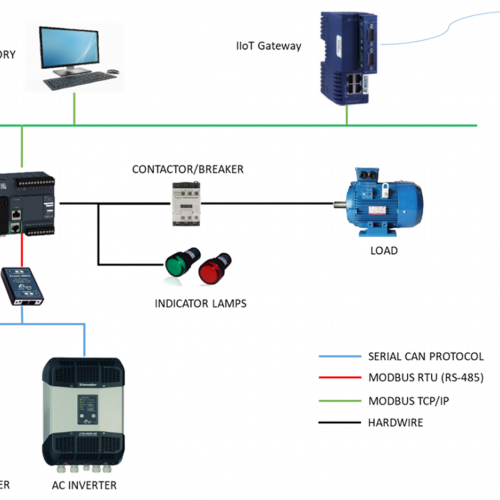
Scheme Architecture Communication System
Use of Laboratory
This Photovoltaic (PV) laboratory encompasses a spectrum of features that enable its operation as a solar power plant under diverse modalities: grid-connected (on-grid), autonomous (off-grid), or a fusion of both (hybrid). It is fortified with anti-islanding protection and facilitates concurrent inverter operation, fostering equitable load distribution amongst inverters. The system further offers automated load management and battery replenishment alternatives through solar panels or the grid. Significantly, even in the absence of an actual power grid, the system can effectively simulate on-grid dynamics utilizing the battery and bi-directional inverter as anchoring references for voltage and frequency modulation. To facilitate the exportation of PV-generated energy to an authentic power grid, the kWh meter necessitates substitution with an import-export variant.
The versatility of the laboratory is exhibited in its role in facilitating experimental engagements and instructional initiatives:
• Design and Installation: Enabling comprehensive instruction encompassing both grid-connected and autonomous installation paradigms.
• Troubleshooting: Equipping students to diagnose and resolve issues within grid-connected and autonomous configurations.
• Instructional Workshops: Offering pedagogical modules that delve into photovoltaic system design principles, typologies of solar panels, voltage-current characteristics, maximal power point tracking (MPPT), Battery Management System (BMS) functionality, grid-interconnection methodologies, off-grid systems, hybrid arrangements, alongside other themes such as anti-islanding mechanisms, bi-directional inverters, lightning safeguards, and meticulous installation protocols.
The facility accommodates up to 15 scholars during each practical session, manifesting a pivotal role in propelling comprehension and research endeavors in Renewable Energy across the expanse of our electrical and electronic department. The laboratory serves as an eminent nucleus for nurturing innovation and experiential learning, culminating in an enhanced grasp of the intricate nuances underpinning renewable energy paradigms. Various practical exercises encompass an array of domains:
1. Understanding How to Measure the Actual Output of Solar Array.
2. Measuring the light Intensity of Solar radiation and ambient temperature.
3. Measuring the input and output of solar charger controller (SCC).
4. Measuring the input and output of solar inverter (On Grid Inverter).
5. Measuring the Input and Output of a Battery
6. Measuring the input and output of a Battery Inverter (Bi-directional Inverter)
7. Measuring the characteristic of the On-grid System.
8. Measuring the characteristic of the Off-Grid System.
9. Trouble Shooting on the Off-Grid and On-Grid Systems.
10. Design and Installation Overview of an On-grid and an Off-Grid System.
11. Training, workshop, and maintenance of PV power systems.
The laboratory stands as a pivotal bastion for the cultivation of innovation and pragmatic learning, accentuating the value of experiential understanding within the domain of Renewable Energy. The prospective trajectory encompasses the expansion of its scope to encompass industrial training initiatives, pioneering research ventures, and the realization of three-phase systems interfaced with the power grid. This trajectory reverberates the laboratory’s profound significance as an erudite crucible for education and pioneering advancements within the arena of renewable energy exploration.
Contact information and Location

Marsul Siregar
Professor
Jl. Raya Cisauk Lapan, Sampora, Kec. Cisauk, Kabupaten Tangerang, Banten 15345, Indonesia
Email: marsul.siregar@atmajaya.ac.id
